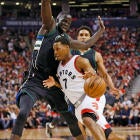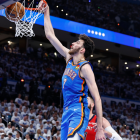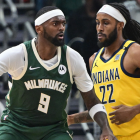The Toronto Raptors couldn't handle the pressure in the opening game of their first-round playoff series against the Milwaukee Bucks. Some might take that to mean that they shrunk for the moment or wilted under the weight of past Game 1 failures. In a literal sense, though, their biggest challenge was dealing with the Bucks' pressure defense. No team in the league has a longer or quicker starting lineup than the Bucks, and that's the basis for everything they try to do defensively.
The Bucks hound ballhandlers. They try to force turnovers. At their best they look like they have an extra defender on the court, swarming around anybody who dares to drive into the paint and recovering to challenge shots on the perimeter. That's what happened in the second half on Saturday, and the Raptors -- owners of the NBA's best offense through mid-January and its sixth-best overall -- looked rattled.
Toronto knew, though, that it could generate good shots by using that pressure against Milwaukee in Game 2 on Tuesday. It would take a combination of patience and decisiveness. It would also take some old-fashioned shot-making.
It was clear early on that the Raptors had placed an emphasis on this. Serge Ibaka got two high-percentage looks in the first few minutes based on DeMar DeRozan drawing an extra defender, giving the ball up and then making the Bucks rotate:
On the first play, Valanciunas got great post position and Ibaka made the perfect cut. On the second one, DeRozan placed his crosscourt pass where even the long-armed Bucks couldn't get to it, so all DeMarre had to do was make the easy extra pass to the corner.
"They're a long team; we had to do a better job of spacing, creating space with screens, zip passes," Toronto coach Dwane Casey said in his post-game press conference. "You can't throw, as my college coach used to say, 'dying quail' passes. I thought we did a much better job putting on-time, on-target passes."
Milwaukee wants to force Kyle Lowry and DeRozan into making bad decisions. The Raptors want their ballhandlers to anticipate the traps before they come and get rid of the ball immediately. Later in the first quarter, DeRozan got a favorable switch: Mirza Teletovic picked him up on the perimeter. When Matthew Dellavedova double-teamed him, he found P.J. Tucker. This pass wasn't perfect, but the result was a wide-open corner 3 -- these are the kind of looks the Bucks have had to live with all year:
"Just watching film, understanding how they're attacking me defensively," DeRozan said. "Trying to put them in rotation. They're sending two guys at me every time I come off a screen. I try to get off it quick, trust my teammates to make the next play. We did a great job of doing that tonight."
Lowry had a bounce-back game, scoring an efficient 22 points after finishing with just four in Game 1. He was more aggressive, as he promised to be, but he wasn't just hunting for his own shots. Early in the second quarter, he came off a screen and caught a pass from Cory Joseph, and suddenly there were three defenders in his vicinity. Rather than getting flustered, he waited a beat for them to recover then attacked the paint. When help defenders converged, he passed it to Tucker in the corner, which triggered two more passes and another 3 for Joseph. On Toronto's next possession, it didn't need all that ball movement -- it just targeted Milwaukee's weaker defenders in a pick-and-roll and Patrick Patterson got an in-rhythm corner 3 out of it:
Patterson has long been one of the league's best complementary players, and his stellar plus-minus over the past few years has reflected that. On offense, his value is that he moves the ball, sets good screens and spaces the floor. With Lowry and DeRozan doing their job of attracting attention and gaining an advantage, watch how Patterson gets two more open looks in the second quarter:
Toronto's floor spacers aren't going to hit every single high-quality look, but the team went 14-for-29 from 3-point range. Also notable: the Raptors had 24 assists on their 37 field goals. They had an elite offense in the regular season despite tying the Phoenix Suns for the lowest assist percentage in the league, per Basketball Reference. In this series, they're going to need to keep moving the ball and punishing the Bucks for leaving shooters open.
"That's what it has to be," Patterson said. "We have to help out those guys in any way possible. All throughout the night they were looking to trap [DeRozan and Lowry] and take them away as much as possible, so we have to do our job collectively of relieving the pressure on them."
Toronto finished the third quarter up 84-83. It was not dominating, but it was dictating the terms of engagement. In the series-opening loss, they scored 83 points total. For the Raptors to have their best chance of taking a 2-1 lead on Thursday, they would prefer a free-flowing, high-scoring game to a grind-it-out slugfest.
None of this is to say that Toronto has figured Milwaukee out. It knew how the Bucks were going to play heading into the series, and it still dropped the first game. The second one went down to the final seconds, with the Raptors losing a lot of their rhythm in the final frame. Wide-open 3-pointers from Malcolm Brogdon and Matthew Dellavedova could have given Milwaukee the lead before Lowry's jumper sealed Toronto's 106-100 win. Casey, though, liked how his team stretched out the traps, got the ball to the weak side and made the Bucks' rotations longer than usual. If the Raptors are going to avoid an upset, they will need to do that consistently.






















